Why do countries trade?
Trade is as old as civilization itself. Before the advent of money, people bartered goods with one another to secure what they could not produce themselves. In trade, one side brings goods or services that it can produce more readily than their trading partner. Pottery, jewelry, metal items and other durable goods are evidence that archaeologists rely on to document the existence of trade among prehistoric peoples.
Influence and Consequences of Trade
The control of trade can be a very significant economic and political factor in the history of a nation. In the late 1200s, Marco Polo traveled over land to Persia (now Iran), then through the Pamir Mountains and the Gobi Desert, to Beijing, China. The book he wrote of his adventures stimulated European interest in trade. Venice merchants became wealthy and used the navy of the city to protect its superiority. Spanish and Portuguese ships set sail for the New World in search of gold and spices but came back with new products like potatoes, sugar and corn that greatly improved European diets. In exchange, they took metal tools and horses that impacted indigenous societies.
For the past several centuries, nations with highly developed manufacturing bases have looked to less developed countries to supply raw materials and to become markets for their products. In the 1700s, Britain and France adopted a policy of mercantilism that sought to protect domestic industries, often at the expense of their colonies. They instituted tariffs on foreign products coming into the country and restricted their colonies from trading with any other nations. This led to global competition for empires. In North America, Britain and France competed for the fur trade along the Great Lakes and the Ohio River valley. In 1763, the British defeated French forces in the battle for Canada and eliminated French influence on the continent. In the United States, the demands for slave labor in the 19th century and in recent times for oil, rubber, foods and metals have greatly influence American foreign policy.
Fair Trade Practices
Sometimes the policies are enforced by military intervention or the support of dictators or the wealthy who permit the practices for the own benefit. Not everyone supports trading practices that put one side at a disadvantage. "Fair trade" rules try to insure that the interests of the producers of the natural resources, often small farmers or factory workers, are protected. Fair trade practices may include demands that the workers who produce the goods receive decent wages and have safe working conditions. The elimination of child labor or sweat shops is often a goal of fair trade negotiations. Those products that follow fair trade practices are allowed to publicize their compliance in the hope the consumers will support their efforts, even if it means the product may cost more than competitors. It is often difficult to enforce fair trade provisions when the source of products is hard to determine. Sometimes consumers prefer the less expensive products despite the manner in which they were produced
Trade in Iowa
Since its first days in the Union, Iowa has been a major exporter of agriculture products. Because of the expense of shipping corn, 19th century farmers converted corn into hogs and shipped meat first by rivers and then by rails. Corn and soybeans are major U.S. exports, especially to Asia. In recent times, disputes over tariffs have been a source of growing tension between the United States and China.
Supporting Questions
Why do countries import and export goods?
- English Map of the Island of Grenada Updated from the 1763 French Survey, 1780 (Map)
- Letter from Thomas Jefferson to Charles Thomson Estimating Imports to the United States, April 22, 1786 (Document)
- Tax Rates on Common Imports to United States, May 16, 1789 (Document)
- Statement of the Quantity of Spirits, Molasses, Coffee, Cocoa and Sugar from the United States, 1818 (Document)
- Trinidadians Sorting Cocoa Pods, 1900 (Image)
- Drying Cocoa on the Island of Dominica in the West Indies, ca. 1906 (Image)
How has the North American Free Trade Agreement (NAFTA) impacted the U.S. and Mexico?
- "Did NAFTA Help Mexico? An Assessment After 20 Years," February 2014 (Document)
- "NAFTA's 'Broken Promises': These Farmers Say They Got The Raw End Of Trade Deal," August 7, 2017 (Document)
- "Why Des Moines and Iowa business leaders support NAFTA," February 7, 2018 (Document)
- "NAFTA Pros and Cons: Why Its Six Advantages Outweigh Its Six Disadvantages" June 25, 2019 (Document)
- "Six Problems with NAFTA," June 25, 2019 (Document)
What are fair trade products?
- Côte d’Ivoire Law Enforcement Rescues Children in Chocolate Industry Forced Labor, June 22, 2015 (Image)
- "Child Labor and Slavery in the Chocolate Industry," 2017 (Document)
- Fair Trade Certified Article about an Indian Factory and Their Use of Community Development Funds, 2018 (Document)
- "Brick by Brick: Rebuilding Public Schools in Côte d’Ivoire," January 23, 2019 (Document)
- Open Letter from a Certified Fair Trade Farm in Amado, Arizona, Date Unknown (Document)
| Trade Teaching Guide |
| Printable Image and Document Guide |
English Map of the Island of Grenada Updated from the 1763 French Survey, 1780
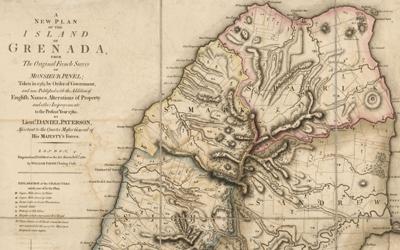
Description
This handwritten map was made from the original French survey of the island of Grenada, located in the Caribbean, by Monsieur Pinel. The new plan was created in 1780 by order of the English government, and was published with the addition of English names, alterations of…
Letter from Thomas Jefferson to Charles Thomson Estimating Imports to the United States, April 22, 1786
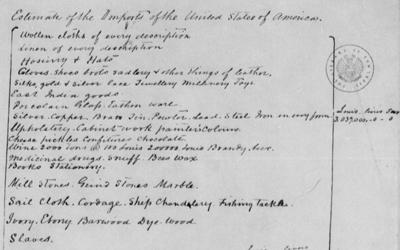
Description
This is one of three pages of a letter sent from Thomas Jefferson which estimated the imports into the United States. Some of the commodities listed include sugar, molasses and salt. Also among the listed commodities from 1786 - "slaves."
Tax Rates on Common Imports to United States, May 16, 1789

Description
This chart from 1789 shows the tax rates on some common imports into the United States. Imports include such commodities like distilled spirits, brown sugar, coffee and cheese.
Statement of the Quantity of Spirits, Molasses, Coffee, Cocoa and Sugar from the United States, 1818
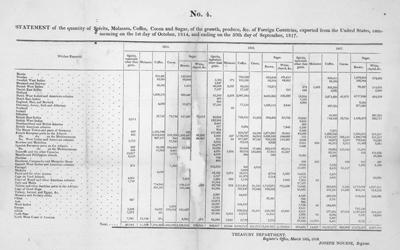
Description
This chart shows common exports from the United States between 1915 and 1918. The chart lists the quantities of spirits, molasses, coffee, cocoa and sugar of the growth that were sent to other countries and territories from October 1, 1814, to September 30, 1918…
Trinidadians Sorting Cocoa Pods, 1900

Description
The photograph shows a group of people in Trinidad that are on the ground with a large pile of cocoa pods. They are splitting the pods to extract seeds for drying, which will eventually be turned into cocoa powder. The image shows the hard work that went into getting cocoa…
Drying Cocoa on the Island of Dominica in the West Indies, ca. 1906
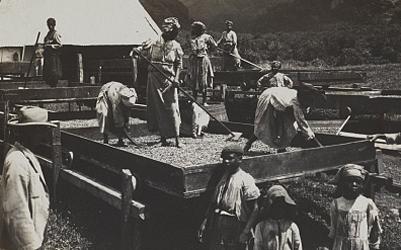
Description
This photograph from 1906 shows local inhabitants, including children, working to dry cocoa beans in Dominica. The island, located in the Caribbean Sea, was a British colony in the West Indies at the time. The British used Dominica in the 1800s as part of the…
"Did NAFTA Help Mexico? An Assessment After 20 Years," February 2014
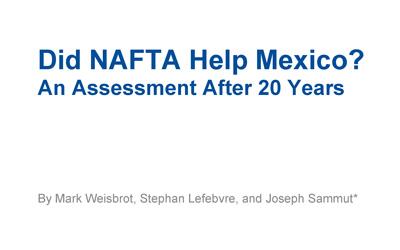
Description
The February 2014 report was published by the Center for Economic and Policy Research (CERP) about the North American Free Trade Agreement (NAFTA). NAFTA was a trade agreement signed by Canada, Mexico and the United States to create a trilateral trade bloc in North America…
"NAFTA's 'Broken Promises': These Farmers Say They Got The Raw End Of Trade Deal," August 7, 2017
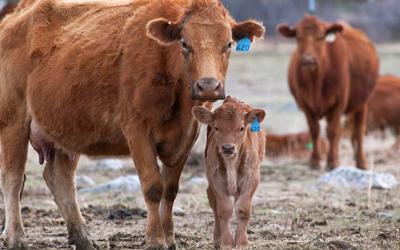
Description
In this article from National Public Radio, "NAFTA’s Broken Promises," the reporters interview ranchers and farmers from Montana and Florida to highlight how North American Free Trade Agreement (NAFTA) has affected their livelihoods. According to the interviewees, the…
"Why Des Moines and Iowa business leaders support NAFTA," February 7, 2018
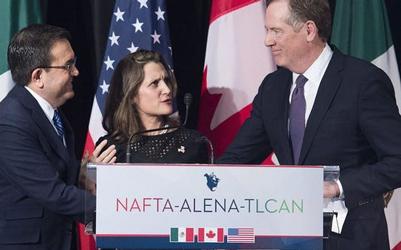
Description
This opinion editorial from The Des Moines Register was written by Jay Byers, chief executive officer of the Greater Des Moines Partnership, and Mike Ralston, president of the Iowa Association of Business and Industry (ABI). Their column focuses on reasons…
"NAFTA Pros and Cons: Why Its Six Advantages Outweigh Its Six Disadvantages" June 25, 2019

Description
Kimberly Amadeo address the pros and cons of the North American Free Trade Agreement (NAFTA), and she makes the argument that the pros outweigh the cons. Amadeo suggests in this article from June 2019 that the little bit of good that NAFTA has been for everyone…
"Six Problems with NAFTA," June 25, 2019
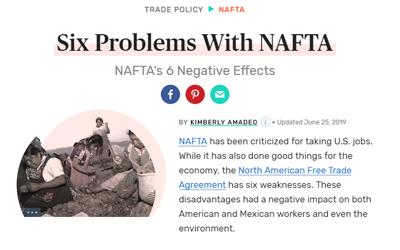
Description
Kimberly Amadeo's article from The Balance explains how the North American Free Trade Agreement (NAFTA) has been bad for both the United States and Mexico. An example she includes is that it cost the United States a lot of jobs, especially in manufacturing. In…
Côte d’Ivoire Law Enforcement Rescues Children in Chocolate Industry Forced Labor, June 22, 2015
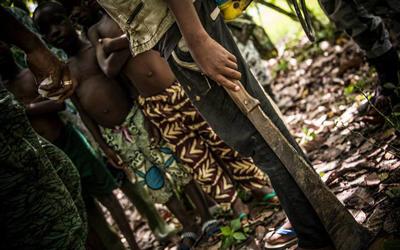
Description
This photograph shows child slaves in the chocolate industry being rescued. The image was distributed by INTERPOL, the International Criminal Police Organization, and it was taken in San Pedro, Côte d’Ivoire, where more than 48 children have been rescued. Twenty-two…
"Child Labor and Slavery in the Chocolate Industry," 2017

Description
This article from the Food Empowerment Project highlights the dark side of the chocolate industry. The article suggests that child slave labor, and unfair compensation for farmers, are driving the industry. It also states that children are working in dangerous…
Fair Trade Certified Article about an Indian Factory and Their Use of Community Development Funds, 2018
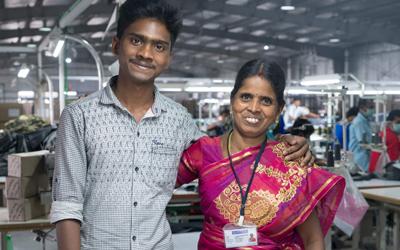
Description
This document highlights how a factory becoming Fair Trade Certified has helped the community in a variety of ways. It focuses on a worker's story from Bestitch Knits, a factory in Tiruppur, India, of a mother being able to use their community funds to send her son to…
"Brick by Brick: Rebuilding Public Schools in Côte d’Ivoire," January 23, 2019

Description
This article explains how Fair Trade community funds in Cote d’Ivoire are being used to build schools and stock them with school supplies. The article suggests that choosing Fair Trade chocolate products directly benefits families in Cote d’Ivorie by providing revenue to…
Open Letter from a Certified Fair Trade Farm in Amado, Arizona, Date Unknown
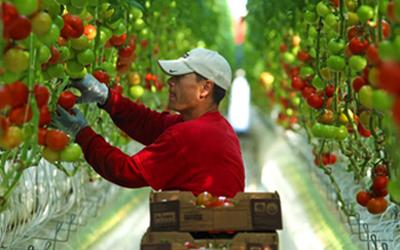
Description
This open letter was written to the Fair Trade Certified organization thanking them for their help in becoming Fair Trade Certified. Since becoming a part of the Fair Trade community, this farm (Wholesum Harvest) has been able to re-invest in health insurance for their…
Additional Resources:
-
Fair Trade Certified
This website provides multiple resources related to "Fair Trade" practices. It includes definitions and examples of companies that are fair trade certified and the impact this as on their community and the global economy. There also is a product feature where the user can search for products to buy that are fair trade certified. -
Food Empowerment Project
This website focuses on the work of the Food Empowerment Project, which seeks to create a more just and sustainable world by recognizing the power of one's food choices. The organization encourages healthy food choices that reflect a more compassionate society by spotlighting the abuse of animals on farms, the depletion of natural resources, unfair working conditions for produce workers and the unavailability of healthy foods in low-income areas.
Iowa Core Social Studies Standards (6th Grade)
Listed below are the Iowa Core Social Studies content anchor standards that are best reflected in this source set. The content standards applied to this set are middle school-age level and encompass the key disciplines that make up social studies for sixth-grade students.
| No. | Standard Description |
| SS.6.18. | Explain how changes in transportation, communication, and technology influence the movement of people, goods, and ideas in various countries. |